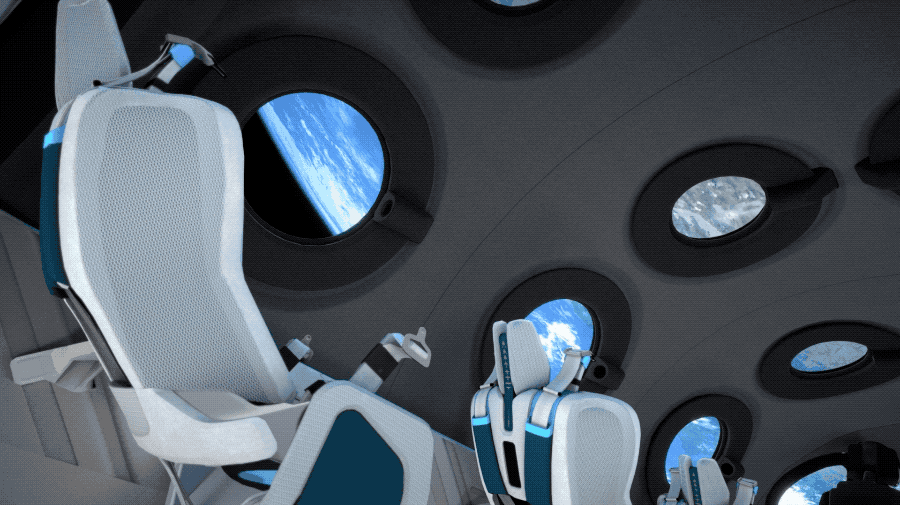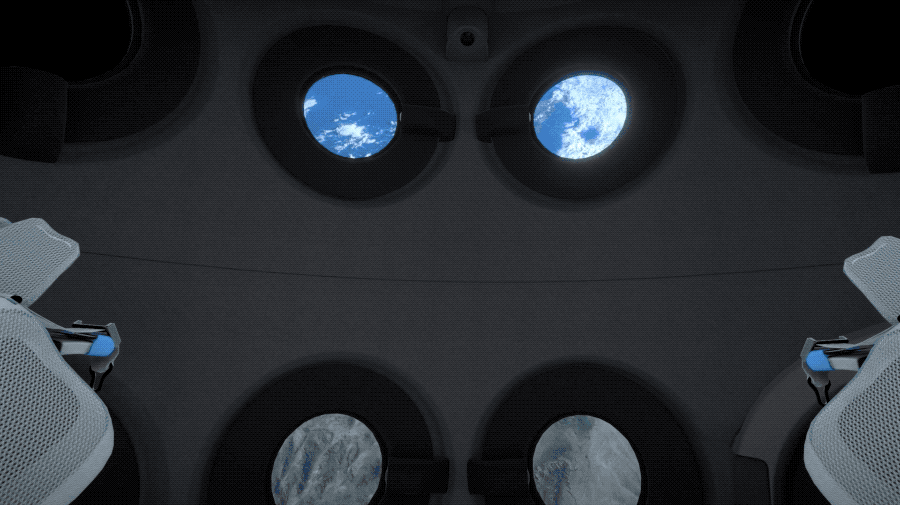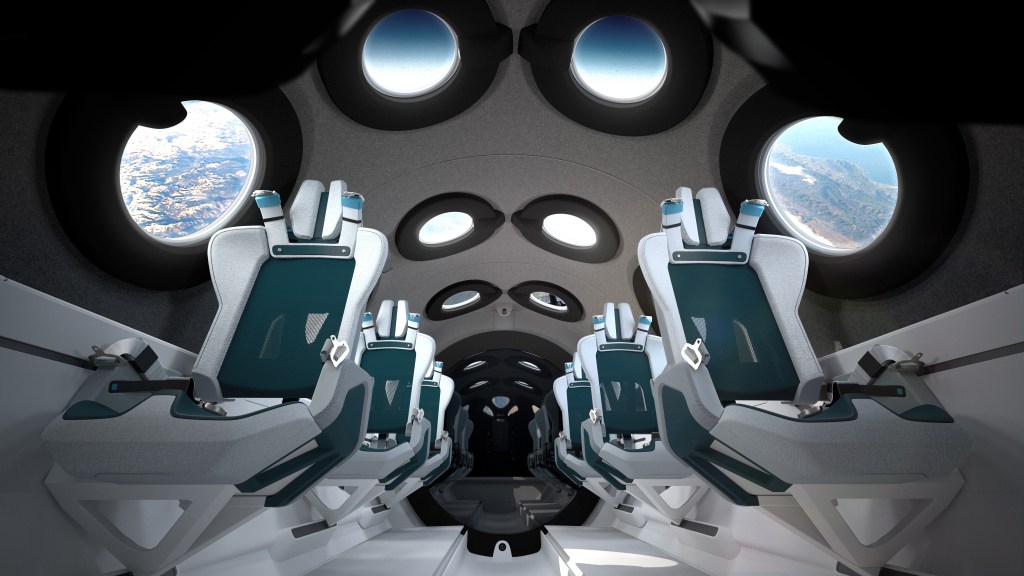As part of its continued preparations to begin its commercial passenger spaceflight operations, Virgin Galactic has revealed the final design of the interior cabin of its VSS Unity spacecraft. The company unveiled the interiors during a virtual event today, and offered members of the press (myself included) a special tour of the interior in VR. The cabin is designed with customer experience top-of-mind, as you might expect for a trip that costs hundreds of thousands of dollars to take.
Virgin Galactic’s VSS Unity will offer up to six passengers an unparalleled trip to suborbital space, where they’ll experience weightlessness in zero gravity and have the chance to observe the curve of the Earth and the blackness of the cosmos beyond the atmosphere. The cabin is entirely designed around optimizing the safety, comfort and freedom of the paying, private astronauts throughout the journey — from the flight up while attached to the carrier craft, to the high-G burn after the Unity separates from that carrier transport, to the free-floating in-space wander, and finally to the high-G return to Earth at a very different inclination from the initial atmospheric exit.
 To make this work, Virgin Galactic created carbon fibre and aluminum seats that combine 3D soft material weaves with metallic, rose gold accents and fabrics created in partnership with Under Armour (which also created the custom spacesuits passengers will wear) to ensure that all private astronauts flying on Unity are as protected and comfortable as possible during the parts of the flight where they’ll experience three times the normal gravity of Earth. These custom-fit seats are tailored in terms of sizing to each individual passenger, and feature thoughtful details like a channel in the centre of the headrest that can accommodate pony tails, for instance.
To make this work, Virgin Galactic created carbon fibre and aluminum seats that combine 3D soft material weaves with metallic, rose gold accents and fabrics created in partnership with Under Armour (which also created the custom spacesuits passengers will wear) to ensure that all private astronauts flying on Unity are as protected and comfortable as possible during the parts of the flight where they’ll experience three times the normal gravity of Earth. These custom-fit seats are tailored in terms of sizing to each individual passenger, and feature thoughtful details like a channel in the centre of the headrest that can accommodate pony tails, for instance.

The five-point harness that’s built into the seats can be unfastened using a single clasp, whereupon the straps with the fastening hardware retract into the seat automatically to ensure they’re safely out of the way during the free-flight zero-gravity portion of the trip, but easy enough to find when they need to strap back in for the return trip.
All the seats are also designed to do double duty as handholds during the free float — as is just about everything else in the passenger cabin. That’s also why the seats have a cantilevered mounting post that offers free space underneath each, which is more room for exploration once the Unity exits Earth’s atmosphere and concepts like up and down lose significance.
 Throughout the cabin, Virgin used soft materials for this same reason, and there are a total of 17 windows throughout the interior (including three for the two-person crew), with each of the passenger-accessible windows rounded with a soft material “halo” complete with a handhold edge and integrated camera. Virgin has put cameras throughout the cabin, in fact, and each provides high-quality photo capture tuned by imaging experts for the specific lighting conditions of the trip. The thinking here is that all the private astronauts should be guaranteed great documentation of their experience without having to worry about actually capturing any of that themselves. Virgin says it’ll be providing some of this imagery pretty much immediately upon landing so that spacefarers can share to their social accounts right away.
Throughout the cabin, Virgin used soft materials for this same reason, and there are a total of 17 windows throughout the interior (including three for the two-person crew), with each of the passenger-accessible windows rounded with a soft material “halo” complete with a handhold edge and integrated camera. Virgin has put cameras throughout the cabin, in fact, and each provides high-quality photo capture tuned by imaging experts for the specific lighting conditions of the trip. The thinking here is that all the private astronauts should be guaranteed great documentation of their experience without having to worry about actually capturing any of that themselves. Virgin says it’ll be providing some of this imagery pretty much immediately upon landing so that spacefarers can share to their social accounts right away.
 Every seat is a window seat, with one to the side and one above, for taking in the breathtaking views. There’s also a large mirror that covers the entirety of the rear bulkhead separating the cabin from the rocket engine, which provides the astronauts the ability to check out their zero-G antics.
Every seat is a window seat, with one to the side and one above, for taking in the breathtaking views. There’s also a large mirror that covers the entirety of the rear bulkhead separating the cabin from the rocket engine, which provides the astronauts the ability to check out their zero-G antics.
The seats also change orientation and inclination based on which part of the journey is happening, from upright for those 3.5Gs on the rocket ride straight up, to a reclined position for the atmosphere-skimming 3G velocity-slowing re-entry. Each seat also has an information display that can provide data about what’s happening during the flight — though the pilot and co-pilot aren’t fully separated from the main cabin, so you can theoretically just ask them questions about the trip live, as well.
Virgin Galactic also took the in-flight mood lighting that its airliner counterpart pioneered and translated it for space, with dynamic lighting reacting to each stage of the trip and emanating from various strategically placed and non-obvious cabin lights. Take a look below for more detailed photos of the cabin interior, including a configuration that allows three passengers but saves room on the other side of the cabin for experiments (one other way Virgin Galactic plans to monetize its service).
The company still has some final preparations yet to do before it can begin flying its paying customers, but with the interior of VSS Unity complete, it’s closer than ever to its goal. This is definitely a unique offering, so it’s hard to judge the product without any available reviewers, but it’s clear that Virgin Galactic has put a lot of thought, consideration and expertise into developing a spaceship interior designed to work for everyone who can afford to take the trip.



































Comment